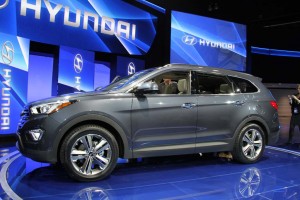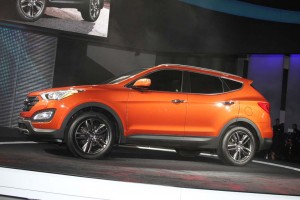
The 2013 Hyundai Santa Fe is a 3-row spinoff of the Santa Fe Sport that went on sale earlier this year.
In the car business, naming vehicles is an art all to itself. But now Hyundai is following a practice pioneered by Ford with its wide range of “F-Series” pickups, and more recently, Toyota with its Prius “family. Now, the Korean carmaker will go the same route, utilizing the Santa Fe name for two distinctly different vehicles.
Hyundai showed off the production version of the latest model to wear the Santa Fe badge, a new three-row six (or seven) seat crossover, at the 2012 LA Auto Show. A two-row, five-seater dubbed the Santa Fe Sport, has been on sale since August.
John Krafcik, the Hyundai of America of chief executive officer once oversaw Ford F-Series engineering. Ford has traditionally treated all the various full-size pickups – from single-row, light-duty models to heavy-duty crew-cab trucks with extended beds – as a single nameplate. The all-encompassing F-Series has been America’s best-selling vehicle for more than 30 years.
Toyota is taking a similar tack with Prius, combining sales of the original hatchback with the newer Prius PHEV plug-in, the bigger Prius V and the compact Prius C.
The approach does risk confusing consumers but it also has a number of advantages. A strong brand name’s halo can be spread across several different models, for one thing. And using the same name also means marketing efforts can be shared, letting a maker’s budget go further, noted Steve Shannon, Hyundai vice president of marketing.
The strategy needs two relatively similar products to work – often, but not always, sharing their basic platforms and key design cues. That’s the case with the Santa Fe and Santa Fe Sport.
Besides the third row seat, the newest version of the Santa Fe will come with a Lambda II 3.3-liter GDI V6 engine making 290 horsepower – enough for towing 5,000 pounds. The engine is shared with the maker’s big Azera sedan.
It will also come with an active cornering control AWD system, driver Selectable Steering Mode, seven standard airbags, panoramic sunroof, heated rear seats and heated steering wheel, Power driver and front passenger seats, sliding and reclining second row seating and 50:50 flat folding third-row seats.
As with the Hyundai Santa Fe Sport, the bigger SUV will come standard with Hyundai’s new Blue Link safety, service and infotainment telematics system.
The three-row Santa Fe increases second-row legroom by 1.9 inches and cargo capacity 5.5 cubic feet and features standard rear-passenger HVAC controls and vents to increase family comfort, while also offering a standard 50:50 split folding third-row bench seat with 31.5 inches of legroom. Second row captain’s chairs are also available on the three-row model.
Hyundai justifies sharing the name for the two models as they are meant to appeal to much the same audience as those who previously bought the single Santa Fe model offered in the past. The Korean carmaker was considering adding an optional third row but decided functionality would be too compromised, according to Krafcik, who told TheDetroitBureau.com the decision was made to offer what are, essentially short and long-wheelbase alternatives.


wondering if it will have blind spot detection and the adaptive cruise control option, anyone have a line on that?
According to earlier comments by Hyundai, yes it will.
Paul A. Eisenstein
Publisher, TheDetroitBureau.com